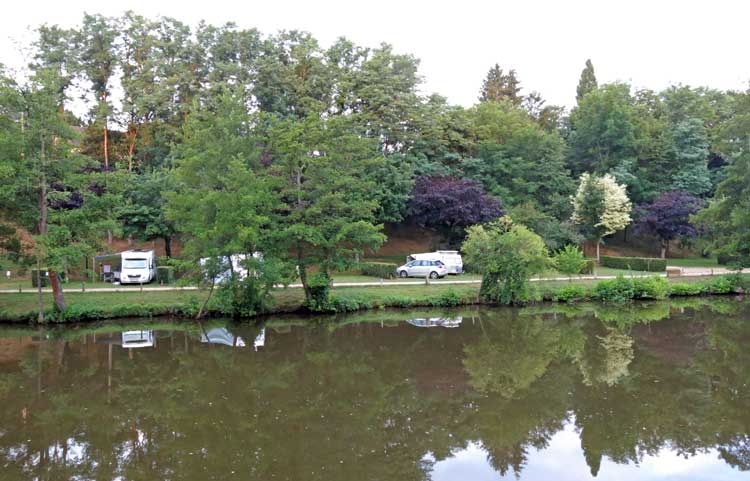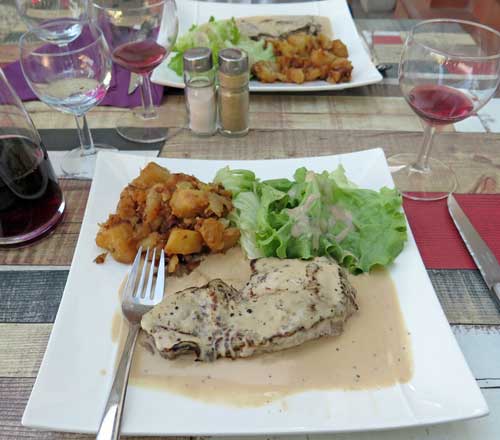
Friday, 14 July 2017
Distance 13 km
Duration 2 hours 35 minutes
Ascent 75 m, descent 83 m
Map 141 of the
Map 140 of the
It was Bastille Day, a public holiday, and we had discovered last night that le Médiéval would not open until late in the morning, too late for us.
The only other bar that we had seen was the fly-blown hovel near the bridge, so we decided not to go back into Hérisson at all, but to walk straight to Vallon-en-Sully and have a second breakfast there. That was about halfway to our destination for the day, a glamorous sounding camping ground

To give us strength for this march, we first had some muesli (an unusual occurrence for us these days), sitting on a playground bench at the village end of the camping ground.
Then we crossed the footbridge, from which vantage point we saw the riverside houses mirrored in the perfect stillness of the river, and then walked along the road, past the camping ground that we had just left, past the broken-down mill and pigeonnier, and out into the fields.

We stayed on the road as it curved around a high spur close to the river, and later followed the base of a steep rise, so that we hardly climbed or descended at all.
The river flats stretched out on our left like a luxurious green carpet, with occasional herds of cows munching away industriously.
After about six kilometres we joined another road, the D110, and parted company with the Aumance, which was heading north to contribute its waters to the Cher.

After surmounting a low, wooded ridge, the D110 shot like an arrow through the fields and hit a bigger road, which took us through the modest outlying houses of the village of Vallon-en-Sully and eventually to the bridge over the Cher, a smart white concrete coat hanger spanning the motionless river.
Despite the fact that it had been an easy walk of only
We had been to Vallon five years earlier, while following the Canal de Berry, and remembered this bar, but we had not been confident that it would still be in operation.

Before sitting down, we went into the village proper for pastries, a detour that involved crossing both the canal and the railway line.
The main street, rising towards the church, had seen better days, with many shops boarded up, but of course there was still a boulangerie.
Although it was only
Returning to the bar with our purchases, we settled down to do what we do best – sitting in front of steaming coffee cups and watching the world go by.
The bar was called le Sullys, and the name had been rendered more exotic by the introduction of an English apostrophe, the only doubtful thing being the position of that apostrophe.
In due course we started off again. I felt lethargic, but hoped that I would find some energy as we went along. At the level crossing, we remembered that one of our favourite towns, St-Amand-Montrond, was just a few minutes by train to the north (or a day’s walk along the canal, as we knew from experience).
A tempting idea crept into our joint mind. We had been walking continuously for a month now, and a couple of days of lazing in a comfortable, familiar place sounded wonderful.
Obviously, if we did that we would not be able to reach our intended destination of Poitiers, but that would not be all bad, because there were a couple of days in our future itinerary that threatened to be pretty gruelling – over 30 km long and devoid of refreshments. Our new target would be la Châtre, a fine little town that we had been to before, on the Way of Vézelay.
We made all these plans in a very short time, suddenly realising how tired we were, both mentally and physically. At the station, there was a timetable attached to the wall, and we were terribly disappointed to read that there would be no more trains until late tomorrow. Nevertheless, we decided to stay at Vallon for the night. Just as we were walking away, the level crossing bells began to ring, the barriers came down, and a train arrived.

Amazed, we rushed back to the station and this time we went inside and asked the station master. It turned out that the timetable outside was a relic of the past, and actually there were plenty of trains, so we booked for tomorrow and emerged well pleased with ourselves.
It was a pleasant walk of about a kilometre along the Canal de Berry to get to the camping ground.
This canal, opened in 1839, was built to a narrower width than other French canals because of a shortage of water to supply the locks, which meant that barges from other canals could not use it.
Traffic declined and it was officially closed in 1955, but it remains a popular feature of the area, especially for cyclists and walkers. On a sign we saw a poignant old photograph, taken at this exact spot, of a family walking along the towpath, with their packhorses pulling a barge.

The camping ground itself was as we remembered it – a wide green field stretching between the canal and the river, dotted with enormous trees.
There were no fixed emplacements, just tents and campervans scattered randomly about.
The ablutions block was high on the levee bank, evidently because the field was prone to flooding, and we had the pleasure of hot showers and clean clothes before stretching out for our afternoon rest.
The thought of tomorrow’s little holiday from our walking routine gave us an edge of happy excitement.
Back at the brasserie at 8 pm, we were lucky to get the last outdoor table, as the place was quite full.
On the menu, three courses were offered for €17, with a fair bit of choice in each course.

The first course was salad with smoked salmon, which we wolfed down with the help of much bread and wine.
Then we moved on to steak (the variety known as faux filet), smothered in green peppercorn sauce and accompanied by a pile of rich sautéed potatoes.
That really started to satisfy our appetites, but there was still dessert to come. Keith chose a glass of assorted ice creams, but I managed to exchange my dessert for a coffee, so we were both happy.
Previous day: Cosne-d’Allier to Hérisson


